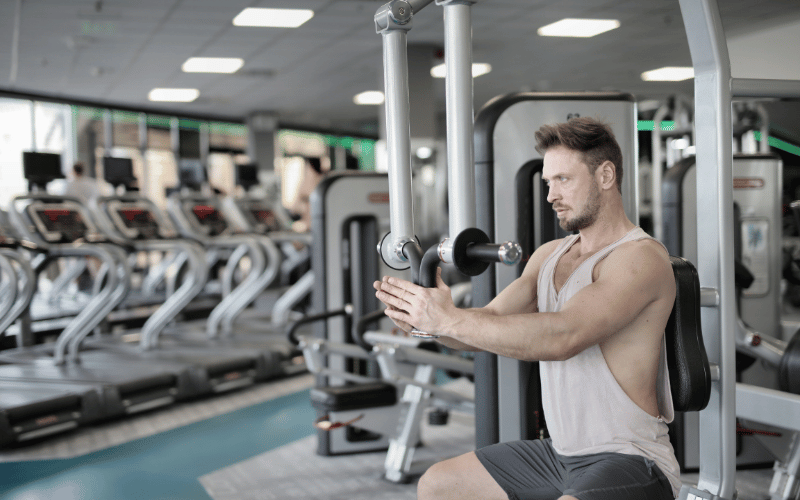Have you ever walked into a gym and felt a bit like you’re facing a “choose your own adventure” with all the strength training options? You’ve got the sleek rows of machines on one side and the imposing racks of free weights on the other. The big question on everyone’s mind, and likely yours too, is: when it comes to building serious strength, which is the best, free weights or machines?
Whether you’re a seasoned lifter aiming to break a performance plateau or just starting your strength journey, knowing the nuances of each can be a game-changer.
Are you ready to unpack the age-old debate of free weights versus machines and discover which might be your ultimate ally in the pursuit of strength? Discover the power of both and find your best bet for getting stronger, the RX Fit way!
Understanding Free Weights and Machines
Alright, let’s break down the stars of our strength-building show: free weights and weight machines. What exactly are we talking about here?
Free Weights

Think dumbbells, barbells, kettlebells, and even medicine balls. The key here is that you are in complete control of the movement.
There’s no fixed path; you have to stabilize the weight, engage your core, and coordinate multiple muscle groups to perform the exercise correctly. It’s like doing a bicep curl with a dumbbell. Not only are your biceps working, but your forearm muscles are stabilizing the weight, and even your shoulders are playing a subtle role in maintaining balance.
Weight Machines

Now, let’s talk about weight machines. These are the contraptions you see with cables, pulleys, and adjustable seats. The defining feature here is that the machine guides your movement through a specific range of motion.
For example, in using a leg press machine, your feet are on a platform, and the machine dictates the path the weight travels. This controlled environment can be fantastic for isolating specific muscle groups and can feel less intimidating for beginners.
Understanding this fundamental difference is the first step in figuring out which option, or combination of options, is your best bet for crushing your strength goals.
Benefits of Free Weights
So, why do so many fitness enthusiasts swear by free weights? Let’s uncover some of the key benefits they bring to the table:
- Enhanced Muscle Activation: Because you’re responsible for controlling and stabilizing the weight, free weight exercises tend to engage more muscle fibers, including those smaller stabilizer muscles that don’t always get much love with machines.
- Improved Functional Strength: Real life isn’t performed on a fixed plane of motion. Lifting groceries, carrying kids, or even just maintaining good posture all require your muscles to work together in a coordinated way. Free weight exercises mimic these real-world movements more closely, leading to greater improvements in functional strength.
- Greater Range of Motion and Versatility: Free weights aren’t confined to a specific path. This allows for a more natural range of motion, which can be beneficial for joint health and flexibility. Plus, the sheer variety of exercises you can perform with a simple set of dumbbells or a barbell is incredible; the possibilities are almost endless.
- Better Balance and Coordination: The instability of free weights forces your body to constantly adjust and maintain balance, which helps to improve your proprioception (your body’s awareness of its position in space) and coordination over time.
- Cost-Effective (Long Term): While the initial investment in a quality set of free weights might seem significant, they can last a lifetime and offer a full-body workout without the ongoing cost or space requirements of multiple machines.
In short, free weights offer unmatched benefits, making them a powerful and versatile tool for anyone serious about getting stronger.
Benefits of Weight Machines
Now, let’s flip the coin and explore the valuable benefits that weight machines offer:
- Isolation of Specific Muscle Groups: One of the biggest advantages of machines is their ability to isolate specific muscles. For example, a hamstring curl machine allows you to focus almost exclusively on your hamstrings, minimizing the involvement of other muscle groups. This can be particularly useful for targeted muscle growth or when rehabbing an injury.
- Guided and Controlled Movement: The fixed path of motion on machines can be beneficial for beginners who are still learning proper form, or for individuals recovering from injuries who need more support and stability. It can help you feel more secure while lifting weight and reduce the risk of incorrect movements.
- Ease of Use and Quick Adjustments: Machines are generally straightforward to use, and adjusting the weight is often as simple as moving a pin. This makes them a convenient option for circuit training or when you want to quickly switch between exercises.
- Potentially Lower Risk of Injury (Initially): Because the movement is controlled, there might be a perceived lower risk of injury, especially for novice lifters who are still developing their coordination and balance.
- Great for Progressive Overload: Many machines allow for small, incremental increases in weight, which is essential for progressive overload (the principle of gradually increasing the demands on your muscles over time to stimulate growth).
In essence, weight machines are an excellent choice for beginners and focused muscle development.
Comparing Strength Gains: Free Weights vs Machines
This is the million-dollar question: when it comes to pure strength gains, who comes out on top, free weights or machines?
Research has shown that both free weights and machines can be effective for building strength. However, studies often suggest that free weights may have a slight edge when it comes to overall muscle activation and functional strength development.
However, it’s important to remember that consistency and proper programming are paramount. Whether you’re using free weights or machines, if you’re consistently challenging your muscles with appropriate loads and proper form, you will get stronger.
Furthermore, the “best” choice can depend on your individual goals and experience level. A beginner might find the stability of machines helpful initially, while a more experienced lifter might prioritize the full-body engagement of free weights to push past training limits.
The key is often a well-structured program that utilizes each tool strategically.
Choosing Between Free Weights and Machines
So, how do you decide whether to gravitate towards the free weight area or make yourself comfortable among the machines? Here are some factors to consider to help you choose what’s best for you:
- Your Fitness Goals: Are you primarily focused on building overall functional strength and athletic performance? Free weights might be your go-to. Are you looking to isolate specific muscles for hypertrophy (muscle growth) or address muscle imbalances? Machines can be incredibly effective.
- Your Experience Level: If you’re new to strength training, machines can provide a more controlled and less intimidating environment to learn basic movement patterns. As you become more comfortable and develop better body awareness, you can gradually incorporate more free weights.
- Your Injury History: If you have a history of injuries, machines might offer more support and allow you to train specific muscles without putting undue stress on vulnerable joints.
- Your Time Constraints: Machines can sometimes be quicker to set up and use, making them convenient for shorter workouts. However, with proper planning, free weight workouts can also be efficient.
- Your Enjoyment: Ultimately, the best type of exercise is the one you enjoy and will stick with consistently. Experiment with both free weights and machines to see what you find more engaging and motivating.
Oftentimes, the most effective strength training programs incorporate a blend of both free weights and machines to maximize their respective benefits.
Common Mistakes to Avoid
No matter whether you’re in the free weight zone or the machine circuit, there are some common mistakes that can hinder your progress and potentially lead to injury. Watch out for these:
- Using Incorrect Form: Poor form can not only reduce the effectiveness of the exercise but also significantly increase your risk of injury.
- Lifting Too Heavy Too Soon: It’s natural to want to challenge yourself, but increasing the weight too rapidly before your body is ready can lead to injury. Focus on mastering the movement with good form before adding significant load.
- Neglecting Stabilizer Muscles (Especially with Machines): If you primarily rely on machines, you might be neglecting the smaller stabilizer muscles that are crucial for overall joint health and functional strength.
- Not Progressing the Load: To continue seeing strength gains, you need to progressively challenge your muscles.
- Ignoring Your Body: Pay attention to any pain or discomfort you feel during your workouts. Pushing through sharp or persistent pain is a recipe for injury.
By avoiding these common pitfalls, you set yourself up for steady, safe gains.
How to Incorporate Both into Your Routine
The good news is, you don’t have to pick just one! In fact, combining free weights and machines can be the most effective strategy for comprehensive strength development. Consider these to integrate both into your routine:
- Start with Compound Free Weight Exercises: Begin your workouts with compound movements like squats, deadlifts, bench presses, and overhead presses. These exercises engage multiple muscle groups and allow you to lift heavier loads early in your workout when you’re freshest.
- Utilize Machines for Isolation Exercises: After your compound lifts, you can use machines to target specific muscle groups that need extra attention. For example, you might follow barbell squats with hamstring curls and leg extensions on machines.
- Incorporate Machines for Higher Repetition Work: Machines can be great for burnout sets or higher repetition work to build muscular endurance in specific muscles.
- Use Machines for Assistance or Support: Some machines, like assisted pull-up machines, can be valuable tools for helping you progress towards more challenging free weight exercises.
- Listen to Your Body and Adjust: Your training should be dynamic. Some days, you might feel more energetic for heavy free weight training, while other days you might prefer the controlled environment of machines.
Using both free weights and machines strategically gives you the flexibility to challenge your body in multiple ways. This unique combination ensures continuous improvement while reducing the risk of injury and burnout.
Wrapping Up Free Weights vs Machines
So, what’s the final verdict in the free weights versus machines debate? The truth is, there’s no single “best” option. Both free weights and weight machines are valuable tools that can contribute to your strength training success.
Free weights offer unparalleled benefits for functional strength and overall athleticism. Machines provide a guided and controlled environment that can be excellent for beginners and those with specific needs.
The most effective approach often involves understanding the unique advantages of each and strategically incorporating both into your fitness routine.
Ready to take your strength training to the next level? Let RX Fit help you find the perfect balance of free weights and machines today!
Frequently Asked Questions
Are free weights better for building muscle than machines?
Free weights are generally better for building muscle because they require more muscle activation and stabilization, leading to greater overall gains. They engage your muscles in a natural way that machines often can’t match.
What are the benefits of using machines for beginners?
Using machines is great for beginners because they offer a safer, more controlled environment that helps you master your form while minimizing the risk of injury.
Can I combine free weights and machines in my workout routine?
Absolutely! Mixing free weights and machines in your routine can enhance your strength training by targeting various muscle groups effectively.
How should beginners start with strength training?
Starting with machines is a great way for beginners to learn proper movement patterns.
What are common mistakes to avoid in strength training?
To really make progress in strength training, steer clear of rushing through your reps, choosing weights that are too heavy, and neglecting proper form.


